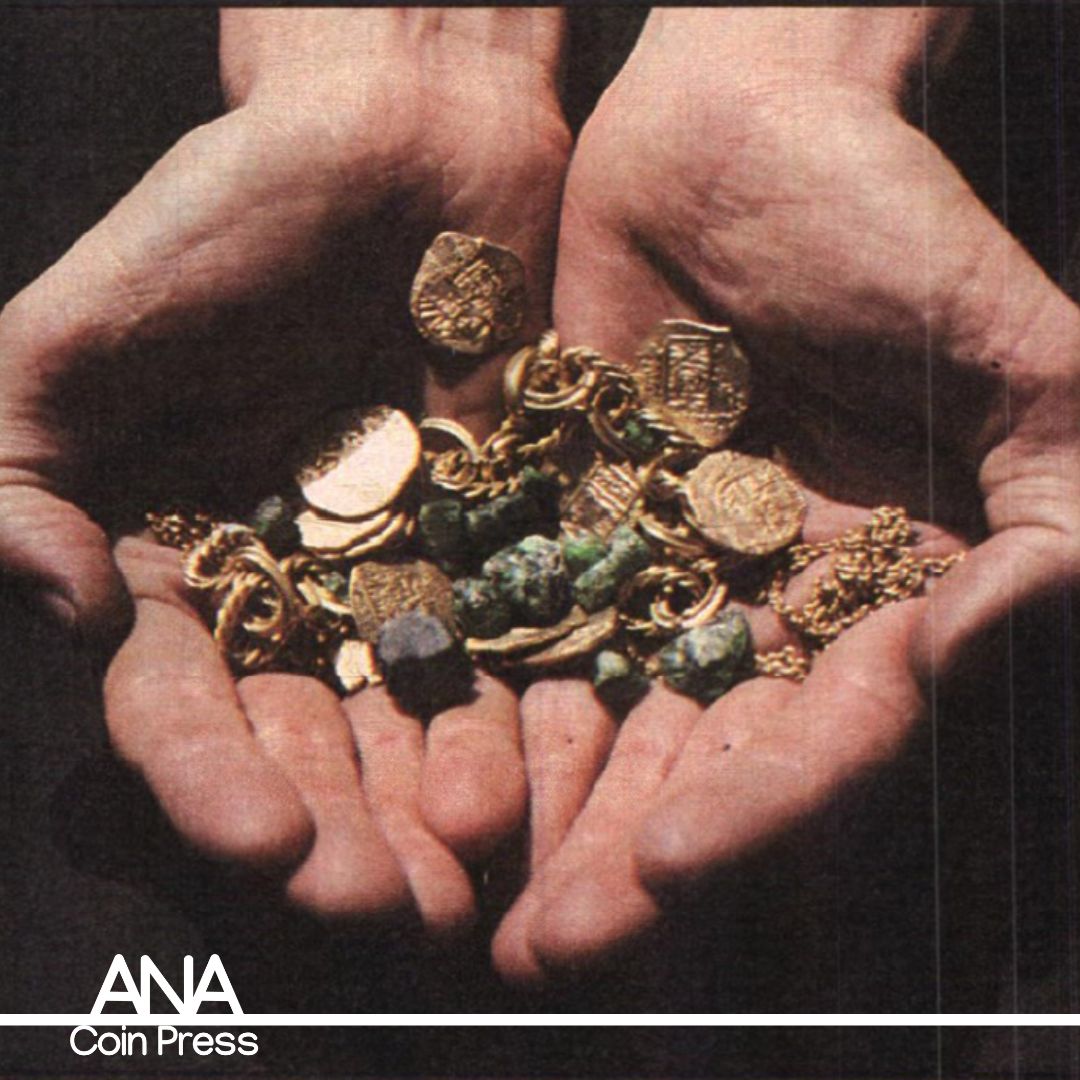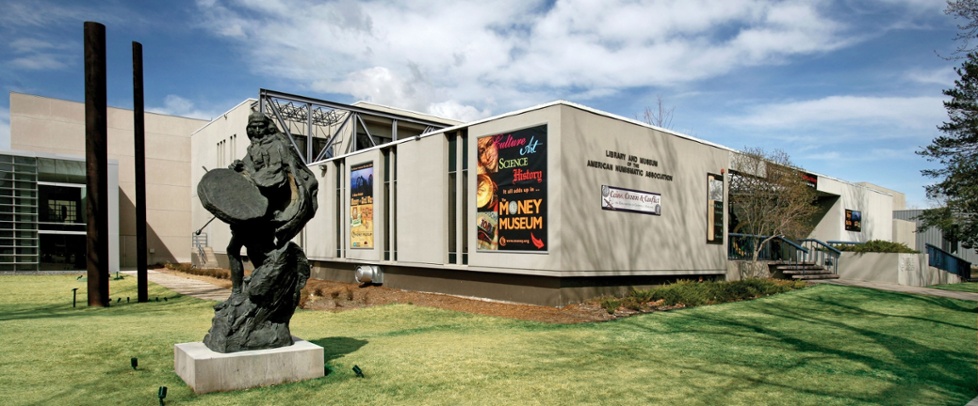Coins of the Nuestra Señora de Atocha
Originally published in The Numismatist — October 1986
A sunken Spanish galleon yields more than 140,000 numismatic treasures.
Little more than a year has passed since Mel Fisher's Treasure Salvors, Inc., after a 16-year search marked by tragedy and hardship, located and began salvaging the rich treasure that was lost with the famed Nuestra Señora de Atocha, a Spanish galleon that sank during a storm in 1622, 41 miles west of the Florida Keys. The find generated great interest in the treasure, Fisher's operation and Key West in general, and has been covered by the media many times over in one manner or another.
A great many people, especially coin collectors, are at the same time skeptical and inquisitive. Mel Fisher has a reputation for being crafty and overly resourceful, and to many his discovery is just another in a long line of unbelievable feats of sea salvage. However, three numismatists have had the good fortune to see the unbelievable with their own eyes. Leah Miguel of Treasure Salvors, based in Key West, Florida, invited members of the American Numismatic Association to examine the Atocha treasure, as well as observe salvage and conservation techniques. Selected to represent the ANA were Kenneth E. Bressett, director of education; Robert W. Hoge, museum curator; and myself, editor of The Numismatist. Jeannette Mobley, an archaeology student at the University of Colorado who had assisted in the ANA museum the previous two summers, accompanied the group at her own expense. Since the invitation included a chance to dive at the site of the Atocha wreck, a six week crash course in scuba diving (completed in three weeks!) was in order, as no member of our trio had any prior experience.
This reconstruction of the ATOCHA is based on the actual construction contract found by Eugene Lyon in the Archive of the Indies in Seville, Spain. The construction of the SANTA MARGARITA was similar, and the outlined area on the sterncastle indicates those portions of the MARGARITA’S hull that were recovered in 1981. TREASURE SALVORS, INC.
The Sinking of the Atocha
Even though the English, French and Dutch challenged the Hapsburg's claims in the Western Hemisphere, Spain remained the most powerful nation in Europe in the early 17th century. To its shores fleets of galleons carried the wealth of the Indies, which was necessary to maintain Spain's high appearance of court, nobility and power.
In the summer of 1622, a fleet of Spanish ships, including the Nuestra Senora de Atocha and her sister ship, the Santa Margarita, took on heavy cargos of royal and private treasure in Cartagena, Portobelo and, finally, Havana. The fleet didn't sail from Havana until September 4-the height of the dreaded hurricane season. Less than 48 hours into the voyage, in the Straits of Florida, the fleet was scattered by a rapidly moving hurricane. Eight ships lost sails, masts and rudders, and were swept toward the Florida Keys.
From the Marquesas Keys to the Dry Tortugas, the ships were tossed upon the reefs and shoals by driving wind and rain. The Atocha struck a shallow reef and sank in 55 feet of water, while the Margarita was swept onward until she grounded six miles north of the Atocha on a wide shoal known today as "the Quicksands." Only 5 crewmen of the 265 persons aboard the Atocha survived, while 68 crewmen escaped the wreck of the Margarita. No passengers from either vessel survived.
The Manifest
According to manifests, or cargo lists, on record in Seville, Spain, the Atocha and the Margarita were laden with gold, silver and copper, as well as tobacco and indigo, a plant valued for the blue dye derived from it. The Atocha carried an estimated 7,175 ounces of gold in bars and discs; 1,038 silver bars; approximately 255,000 hand-stamped silver coins from mints in Potosí, Lima, La Plata, Mexico City and Santa Fe de Bogotá; 15 tons of Cuban copper; 300 bales of indigo; and 500 bales of tobacco.
The Atocha's silver cargo totaled more than 47 tons, each bar weighing roughly 75 pounds, while the Margarita carried about half as much. Each bar bore a registry number, owner's marks and the bar's weight, which, along with the name of the shipper and owner, were carefully recorded in the manifest by the ship's silvermaster. "Legal" bullion was marked with the sello real, or tax stamp, indicating the royal tax had been paid.
Though officials were judicious about logging the legal shipments, smugglers were just as careful not to register their precious items. Smuggling was rampant at the time, even though the penalty for trafficking gold was 200 lashes and 10 years chained to an oar in a Spanish galley. Many of the gold bars retrieved from the Atocha and the Margarita are crudely cast, showing no evidence of tax stamps—proof positive that they were contraband. In addition, gold coins, nuggets and chains, and numerous emeralds were found, virtually none of which were listed in the manifest.
The Indefatigable Fisher
By the time Ken, Bob and I completed our dive training, we began to question whether we'd be able to put our new skills to use. Because of Fisher's cloudy reputation, some encouraged the ANA not to send its representatives to Key West, feeling that the Association might suffer some embarrassment. However, the ANA decided to proceed with its plans.
Throughout most of his 20-odd years of treasure hunting, Mel Fisher has been dogged by controversy. In 1963 he sold his chicken ranch in California
and moved to Florida to comb the ocean for the treasure of the 1715 Spanish Plate fleet, lost off the Florida coast around Vero Beach. Soon after, he found it.
With money in his pocket, he began his quest for the Atocha, the "Big A.” However, his source of information was unreliable, and in 1966 Fisher began his search in the wrong area, approximately 10 miles southwest of Key Largo near present-day Islamorada.
[IMAGE] Treasure Salvors' headquarters and exhibit area is maintained in an old Navy base building, a block from Key West Harbor.
Frustrated, Fisher contacted historian Eugene Lyon, who was researching his doctoral dissertation at the Archive of the Indies in Seville, Spain, and persuaded him to look for references to the lost galleons. Finally, in February 1970, Lyon found a remarkable document—a detailed expense report by Francisco Nunez Melian for the salvage of the Santa Margarita. The worm eaten document led Lyon to believe the fleet was lost around the "Cayos del Marquez," now known as the Marquesas Keys, more than 100 miles from where Fisher had been searching.
Fisher promptly moved his base of operations to Key West, 35 miles east of the Marquesas. He logged more than 120,000 linear miles before finding a huge galleon anchor in June 1971, the same size and shape as those carried by the Atocha and the Margarita, along with silver coins, gold bars and chains, and several matchlock muskets. The coins were dated 1621 and earlier. Undoubtedly, he had found one of the richly laden galleons, but which one?
No more significant discoveries were made until 1973, when Fisher's divers found thousands of silver coins, more gold bars, chains and muskets, and three large silver bars. Eugene Lyon again came to the rescue, deciphering the markings on the bars as those listed on the manifest of the Atocha. Fisher had indeed found treasure from the legendary vessel.
Throughout this period, Treasure Salvors and other such operations labored under permits issued by the State of Florida, which, in most cases, took 25 percent of the recovered goods. On the surface this arrangement did not seem unfair; however, salvors of ten waited years before they received their shares.
In early 1975, the Supreme Court of the United States ruled on Florida's coastal boundaries which clearly placed the Atocha in international waters, beyond the control of the State of Florida. Nevertheless, the United States government claimed ownership of 100 percent of the treasure. To protect its 75-percent share, Treasure Salvors filed an admiralty action in the U.S. District Court, claiming discovery and rightful ownership of the treasure. The legal battles were costly, and, though Fisher eventually won, his operation's finances were severely threatened.
Cannons and Tragedy
Then, on July 13, 1975, Fisher's son Dirk found nine bronze cannons, each weighing approximately 1½ tons. Using information provided by Eugene Lyon, the markings on the cannons were matched to those listed in the armament segment of the Atocha manifest. Treasure Salvors was finally on the trail of the "Mother Lode," the main wreck of the Atocha—or so everyone thought.
At the height of the excitement tragedy struck. Dirk Fisher, his wife Angel and a crew of divers anchored near the Marquesas Keys late one afternoon so that they might begin work early the next day. During the night a leak developed, and their boat, the Northwind, rapidly took on water, capsized and sank. Though eight crew members managed to escape, Dirk, Angel and diver Rick Gage did not.
For three years following the unhappy accident, the search for the Atocha continued without any new finds or clues as to the true location of the bulk of the treasure. By 1979 Fisher had spent 12 years and $6,000,000 searching for his dream-to many, an impossible one to fulfill.
The Search Continues
On a hunch, in Winter 1980 Fisher decided to check an area that he had marked previously. With the aid of a magnetometer, an instrument that detects the presence of iron objects, he found some old anchors and a large quantity of ballast stones of the kind used to stabilize cargos in the holds of 17th-century galleons. This find was only the beginning. By the following spring, Treasure Salvors had uncovered the Margarita. Although it was not the treasure Fisher sought, the find was enormous, yielding $20 million.
The discovery of the Margarita, though indeed satisfying and exciting, did not sway Fisher from his ultimate goal of finding the Atocha. Duncan Mathewson, marine archaeologist for the operation, had developed a theory that the Atocha lay south-southeast of the Quicksands in deeper water. Kane, Fisher's youngest son, adopted Duncan's theory and plotted a path from the Quicksands to the site of the Margarita and beyond.
For three years little was discovered of any great importance—a coin here, a ballast stone or two there. However, enough was found to maintain their interest in what now had come to be known as "Kane's Line." By Spring 1985 most everyone was beginning to think that surely they were too far east. Then, on May 27, Memorial Day, the sea yielded another offering-13 gold bars and 16 emeralds in magnificent gold settings. Surely they were on the right track! But the next five weeks turned up nothing.
A map illustrating the basic locations of the major finds can be found in Treasure Salvors' chart room.
Then, on July 19, Cartographer Ed Little emerged from his chart room and asked Bleth McHaley, vice president of Treasure Salvors, if she would "like to see the Atocha." Ed showed Bleth a side-scan sonar reading that he was convinced represented the elusive ship. After an agonizing night of anticipation, Kane positioned his unsightly coastal rig Dauntless over the spot, wondering if the instrument readings were right. Was the mother lode below?
He lowered the "mailboxes," two large elbows of pipe, from their stem mountings into the water. (Developed by Mel Fisher and now used by most sea salvors, the pipes carry turbulent water from boat's propellers to the ocean floor, blowing the shifting sand away from whatever might lie beneath.) Two miles from the Memorial Day discovery, two divers—one with a portable metal detector—descended into the crater blown by the mailboxes.
Greg Wareham saw numerous coins at the bottom of the crater but swam away to see if he could spot anything else. Soon he returned, motioning to Andy Matroci to follow him. In minutes, Andy knew of Greg's excitement. A reef-like mound composed of stones, copper ingots and dark bars shaped like loaves of bread sent their metal detector screaming. They had found it! The mound was 70, maybe 80 feet long, and half as wide. Kane's Line had paid off—they had tracked the Atocha to its tragic end.
The Treasure
The most precious items naturally were salvaged first. Nearly 40 tons of silver bars have been recovered, along with a number of gold bars and a staggering quantity of emeralds. As of May 15, 1986, Treasure Salvors had retrieved nearly 450 emeralds weighing a total of 1 ½ pounds. The following week, another 174 green gems were found, and the next weekend an astounding 2,300 more were located. One "granddaddy" stone weighs 77 karats, and a number of others range from 30 to 40 karats-all natural, uncut gems.
Other artifacts, too numerous to mention here, have been recovered as well—silver plates, vases, goblets, utensils and gold jewelry. Many of the gold chains are 20 to 30 feet long, with one measuring 50 feet! Thousands of pottery shards, along with some intact ceramic items, are being studied for composition and origin.
The photographs above and at right present a diver's view of the coin "chests" and silver bars as they appeared on the ocean floor. ANDY MATROCI
Rapiers, muskets, musket balls and other weaponry have been found, as well as hundreds of personal items, such as beads, buttons, chain links, rosaries and crucifixes. Also found were 43 full and 28 partial or broken coin "chests," numerous small clumps of coins and many thousands of loose coins, totaling more than 140,000 specimens. That's what we three from the ANA wanted to see.
ANA Arrives
During our five-day visit, we met the staff at Treasure Salvors' Key West headquarters and observed its activities. Of course, we were most interested in the salvage and conservation techniques employed and spent most of the first day familiarizing ourselves with the operation's different departments—administration, processing, conservation, research and exhibits. We took time out to rent scuba-diving gear in preparation for the next two days at the wreck site, 41 miles to the west.
The Dive
The next morning, with Ted Miguel, Treasure Salvors' director of dive operations, at the helm of his 22-foot boat, Ken Bressett, Robert Hoge and I, along with "Doug" Douglas, an investor and member of the board of Treasure Salvors, headed out of Key West harbor for the hour-long voyage to the wreck site.
We landlubbers were a bit nervous about our first dive in the ocean's vast salt waters. (Our initial diving class was conducted in a municipal swimming pool in Colorado Springs; our final certification dive took place in a cold, murky reservoir in Denver a week before we departed for Key West.)
Thirty-five miles out we approached the Marquesas Keys that we had read so much about, and soon we could see three boats anchored close to one another. The largest, the 97-foot Magruder, was flanked by two smaller boats, the Dauntless and Swordfish. The boats weren't quite what we expected. Although they appeared sea worthy, the vessels seemed a bit decrepit and ungainly with their rusty, unpainted hulls and the "mailboxes" dangling astern.
The SWORDFISH, one of the vessels used to recover the ATOCHA treasure
By then it was almost noon. The temperature was in the low 80s, but humidity was high and the sky was partly cloudy. As Ted navigated his boat around the stem of the Magruder, the ocean seemed choppier than before, particularly with the proximity of the bobbing vessels. We boarded the main salvage craft and loaded the diving gear aboard, flushed with anticipation of our first real dive. After having some lunch, we met the crew and Captain Dick Klaudt, who, along with Giacomo Amoroso, the divemaster, briefed us on diving procedures.
Next, Ken, Bob and I inspected some artifacts that were salvaged only a few days before, including a dozen or so small emeralds, some 8-real coins, a silver plate and a lead papal seal that presumably had been affixed to a religious document at one time.
Finally, it was time to dive. As we donned our gear, we were informed that the boat was anchored about 100 yards southwest of the main site. Overwhelmed by a now-or-never feeling, we stepped down a ladder over the port side into the emerald green water. After receiving a signal that all systems were go, we swam to the stern of the boat to locate a line that we could follow down to the bottom. As we descended, hand over hand, the dive crew watched our every move, not to monitor our honesty, as we first suspected, but to ensure our safety.
Shortly after reaching the excavation site, 54 feet below, Bob's buoyancy control jacket malfunctioned, inflated and dangerously shot him to the surface like a cork. The crew immediately came to his aid, determined that his lungs had not been damaged by the rapid change in water pressure, and helped him solve the problem. Meanwhile, Ken and I, oblivious to Bob's little scare, anxiously investigated the bottom. The ocean floor was devoid of vegetation-nothing but pulverized coral and broken shells. Once Bob rejoined us, Vince Trotta, one of the Magruder's divers, pointed out some ballast stones and handed one to each of us, as we were extremely buoyant because of our high level of excitement. The extra weight fixed that.
Thirty minutes later, we surfaced and scaled the ladder to the Magruder's deck. It was an exhilarating first experience, but at the same time a little anticlimactic. We really didn't see much, other than a few ballast stones, pottery shards and some barrel hoops.
A Glimpse of the Wreck
The next days' dive was definitely more exciting, yet sobering. We arrived aboard the Magruder for lunch, and then transferred to the Swordfish to dive on the "primary cultural deposit," the remains of the hull of the Atocha.
Tom Ford, captain of the Swordfish, briefed us as to what we might expect to see. One by one, we went over the port side, tingling with excitement. As the three of us descended, we slowly began to see dark areas that were the remains of the hull timbers.
Suddenly, a chill engulfed us as we realized that we were looking upon the watery grave of 260 Spaniards who perished three and a half centuries ago. No obvious signs of treasure, for most had already been brought to the surface and taken to Fisher's headquarters for immediate conservation, security and display. All that remained were timbers, tons of ballast rocks, a pile of copper ingots, a few small pieces of pottery, and a gloomy pall. At one point, Bob Hoge paused to survey the scene, nearly straddling a large nurse shark. (Although not particularly humorous at the time, we all laughed about the incident once we were safe aboard the Swordfish.)
Kenneth Bressett {left), ANA director of education, and N. Neil Harris, editor of THE NUMISMATIST, study some of the raw emeralds brought up from the ocean floor.
In the chart room of the MAGRUDER, locations of recent salvage efforts are plotted.
The author takes one more calming breath before heading over the side of the boat.
Tom Ford. captain of the SWORDFISH, prepares Ken Bressett (left) and Neil Harris (right) for the ATOCHA dive.
[Image Right] "Doug" Douglas, a Treasure Salvors investor, inspects a reassembled example of pottery recovered from the ATOCHA. [Image Left] ANA Museum Curator Robert Hoge studies a gold bar.
Studying the Coins
The fourth day began our close study of the coins and Treasure Salvors' conservation techniques and grading system. We visited with Sandy McKinney, resident expert on the Atocha coin hoard and executive director of the Mel Fisher Maritime Heritage Society, Inc. She explained that of the 140,000 coins recovered thus far, only 80,000 have been cleaned or processed. Eighteen full or partial "chests'' comprised approximately 50,000 of the examined pieces, the rest being single coins or small clumps.
The "chests" actually are huge blocks of encrusted coins that assumed the shape of the chests or boxes in which they were contained; the six board wooden boxes themselves were very fragile and in many instances had totally disintegrated. (Such chests were crude and more crate-like than the treasure chests we fantasized about as children.) The coins appear to have been placed in the chests at random, for specimens from both the Mexico Mint, dated as early as 1607 and as late as 1616, and the Lima Mint, dated between 1572 and 1578, were represented in every chest.
Great piles of silver bars recovered from the ATOCHA repose in the exhibit area at Treasure Salvors' headquarters.
Coin "chests" that have yet to be separated and cleaned are displayed at Treasure Salvors' headquarters.
Ken Bressett closely inspects a coin "chest."
The heaviest chest weighs 140 pounds and has yet to be processed. A 137-pound chest revealed 2,516 coins, all 8 reales, while a chest of 2-real coins weighing 124 pounds yielded 7,139 pieces. The most common coins processed thus far are silver 8-real pieces struck at the Potosi Mint, attributed to assayers T or Q and bear the dates 1622, 1621 and 1617. At present, only 67 gold coins have been recovered, most of them 2-escudo pieces dated from the 16th century and originating from Spain's Old World mints.
Coin Conservation
Reclamation of the encrusted coin "chests," rigidly bound in a matrix of silver chlorides, sulfides and calcareous deposits, posed quite a challenge. Over the years Treasure Salvors has tried many methods of freeing and cleaning the coins. Currently employed is a three-step process that enables them to clean hundreds of coins at one time.
Naturally, the first step is to remove the coins from their bondage. Arrocon 726, a substance used in the textile industry, successfully removes the calcification without eroding the coins' silver composition. A clump of coins is soaked in this solution, which in turn transforms the calcification into a more manageable, mud-like goo that can be easily rinsed away, leaving most of the coins as single, though still heavily encrusted specimens.
Bob Hoge examines coins undergoing electrolysis.
Freshly processed coins from an ATOCHA coin "chest."
Next, the specimens undergo electrolytic reduction, whereby the coins, which act as cathodes, are suspended from alligator clips in a solution of 5-percent sodium hydroxide along with a stainless steel plate, which serves as the anode. A carefully regulated electric current is passed through the coins, causing the deposits on them to ionize and migrate to the positively charged steel plate. Each tank can process about 600 coins every 48 hours.
Following a thorough rinsing to remove the electrolyte and any remaining sulfides, the coins are ready for the last step. For 10 minutes they are turned over and over in a lapidary tumbler filled with a liquid burnishing compound and fine steel shot, much the same manner in which modern-day mints prepare planchets for coins and medals intended for sale to collectors. After a final rinsing, the coins are clean and bright, and their legends are rendered more legible than with other methods of cleaning.
The coins are kept together according to their original clumps so that information about the contents of each chest can be studied and analyzed. The coins are sorted by mint and assayer, if possible, and returned to the curatorial department for a second, more careful sorting. Each coin then is assigned a number and entered on a computer system, which records a digital image of both obverse and reverse.
For numismatists, coin cleaning is a very controversial subject. However, in the case of sea-salvaged coins from the 16th and 17th centuries, Treasure Salvors' conservation process appears to be reasonable and practical, especially considering the monumental task of conserving more than 140,000 specimens, with more pieces being salvaged almost daily.
Coins of the ATOCHA
The coins illustrated here were selected by Sandy McKinney and the author from Treasure Salvors' research collection and are representative specimens from the hoard of the Nuestra Senora de Atocha, many of which previously were considered very rare.
The New World silver coins are fascinating, as no two are alike. Each was hand-struck and carries the coat-of-arms of the reigning Spanish monarch; the reverses feature a cross quartered by the lions and castles emblematic of the Spanish kingdoms of Castile and Leon. The coins, known as macuquinas, or cobs, were cut from long, thin bars of silver and issued in denominations of ¼, ½, 1, 2, 4 and 8 reales.
The following catalog lists, in chronological order according to mint, the denomination, the monarch under whose reign the coin was issued, assayer, date (or the period in which the coin type is known to have been issued), and any comments necessary for a clearer understanding of the piece.
As far as is known, the Colombian Nuevo Reino de Granada coins from the Bogota Mint bearing RN or S mint marks and the mark of assayer A are unrecorded outside the Atocha recovery. The first assayers at the Potosi Mint appear to have been B and R, as illustrated by the Philip II coins (numbers 19 and 20). All dated assayer M coins bear the year 1617, while dated R/L assayer coins are marked 1618.
SILVER COINS
Lima Mint
1. 2 reales, Philip II, Assayer R, c. 1572. Early Carlos and Juana shield.
2. 2 reales, Philip II, Assayer R, c. 1573- 75. Hapsburg shield; note no "H" in ISPANIARUM.
3. 2 reales, Philip II, Assayer X, c. 1572-73.
4. 2 reales, Philip II, Assayer M, c. 1572-73.
5. 2 reales, Philip II, Assayer M, c. 1572-73.
6. 4 reales, Philip II, Assayer M, c. 1572-73.
7. 8 reales, Philip II, Assayer M, c. 1572-73.
8. 2 reales, Philip II, Assayer B (overstruck with L), c. 1574.
9. 4 reales, Philip II, Assayer B (overstruck with L), c. 1574.
10. 2 reales, Philip II, Assayer L, c. 1575-77.
11. 2 reales, Philip II, Assayer D, c. 1577-78. P/II at left, o/D/* at right.
12. 2 reales, Philip II, Assayer D, c. 1577-78. P/II at left, */o/D at right.
13. 2 reales, Philip II, Assayer D, c. 1577-78. */II at left, P/./D at right.
14. 4 reales, Philip II, Assayer D, c. 1580-88. P/4 at left, */o/D at right.
15. 8 reales, Philip II, Assayer D, c. 1580-88. */8 left, P/o/D at right.
16. 8 reales, Philip II, Assayer D, c. 1580-88. P/8 at left, */D at right.
La Plata Mint
17. 2 reales, Philip II, Assayer B (erased), C below, c. 1574.
18. 8 reales, Philip II, Assayer B (erased), C below, c. 1574.
Potosí Mint
19. 8 reales, Philip II, Assayer B, c. 1575. The first coins minted in Potosí used Lima dies.20. 8 reales, Philip II, Assayer R, c. 1576.
21. 8 reales, Philip II, Assayer A, c. 1592.
22. 2 reales, Philip III, Assayer R/L (monogram), partial date (1618). Anomaly o/T, where o/II usually is located.
23. 4 reales, Philip III, Assayer R/L, full date (1618).
24. 8 reales, Philip III, Assayer R/L, c. 1618
25. 8 reales, Philip III, Assayer R/L (over struck with T), full date (1618).
26. 8 reales, Philip Ill, Assayer B, c. 1599·1609.
27. 8 reales, Phillip Ill, Assayer R, c. 1599·1616. Note difference in shape of R as compared to Philip II issues.
28. 8 reales, Philip III, Assayer M, 1617.
29. 8 reales, Philip III, Assayer T, 1619.
30. 8 reales, Philip II, Assayer T, 1620.
31. 8 reales, Phillip III, Assayer T, 1621.
32. 8 reales, Philip IV, Assayer T, 1622.
Santa Fe de Bogotá Mint
33. 8 reales, RN mintmark, Assayer A, partial date (x62x). Mint of origin assumed to be Santa Fe de Bogotá.
34. 8 reales, RN mintmark, Assayer A, full date (1622). Mint of origin assumed to be Santa Fe de Bogotá.
35. 4 reales, S mintmark, Assayer A, full date (1622). Piece still being researched; mint of origin uncertain.
36. 4 reales, full date (1622). Mint of origin uncertain; assayer not visible; obverse shows coat-of-arms of Granada at bottom of shield, later known as insignia of Santa Fe de Bogotá.
37. 2 reales, full date (16221. Because of die similarities, mint of origin assumed to be Santa Fe de Bogotá.)
Mexico Mint
38. 2 reales, Carlos and Juana, Assayer O, c. 1556.39. 8 reales, Philip III, Assayer A, c. 1600-09.
40. 8 reales, Phillip III, Assayer F, c. 1603-15.
41. 8 reales, Philip III, Assayer D, c. 1614-21.
GOLD COINS
Madrid Mint
42. 2 escudos, Assayer G, c. 1615-20.Burgos Mint
43. 1 escudo, Carlos and Juana, before 1545. Shell at right.Seville Mint
44. 1 escudo, Carlos and Juana, c. 1537. Star at right.
45. 2 escudos, Philip II, before 1598. Mint and assayer not visible but thought to be a product of Seville Mint.
46. 2 escudos, Philip III, Assayer G, 1613. Symbol for Granada in center of shield.
47. 2 escudos, Phillip Ill, Assayer G, partial date (16xxl. Symbol for Granada at bottom of shield.
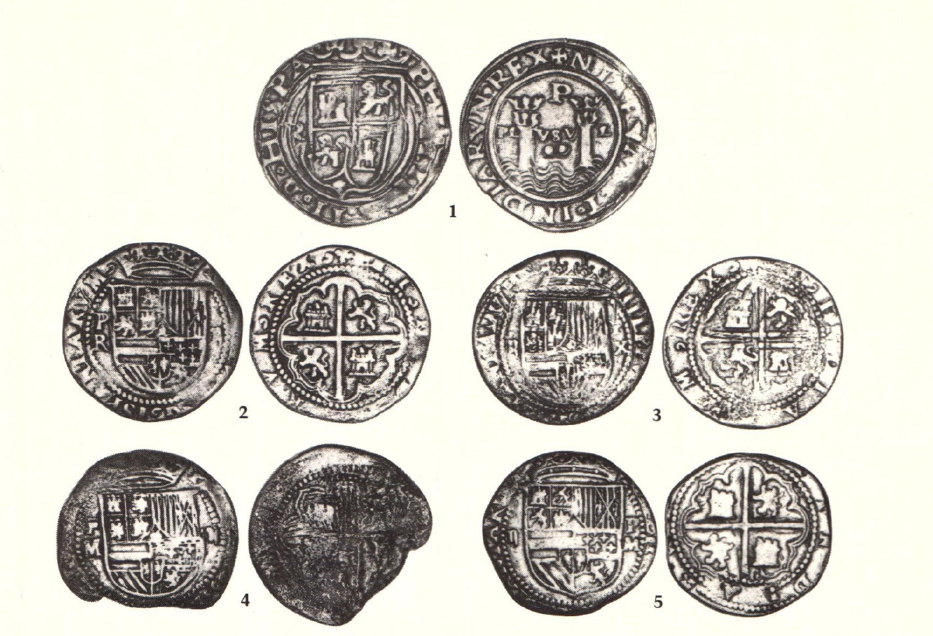
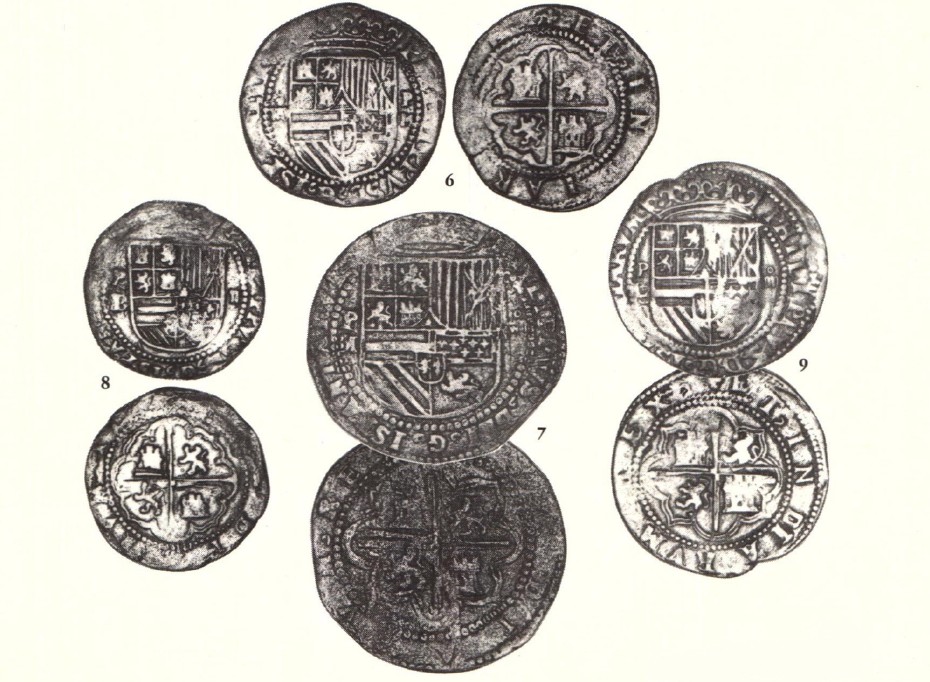
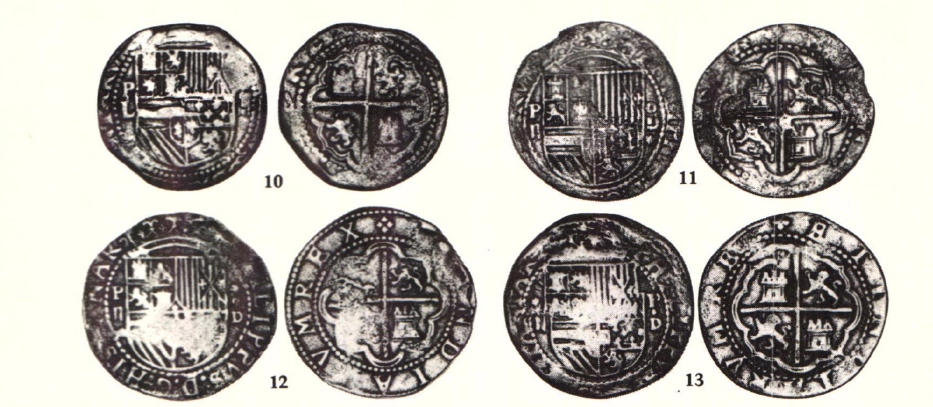
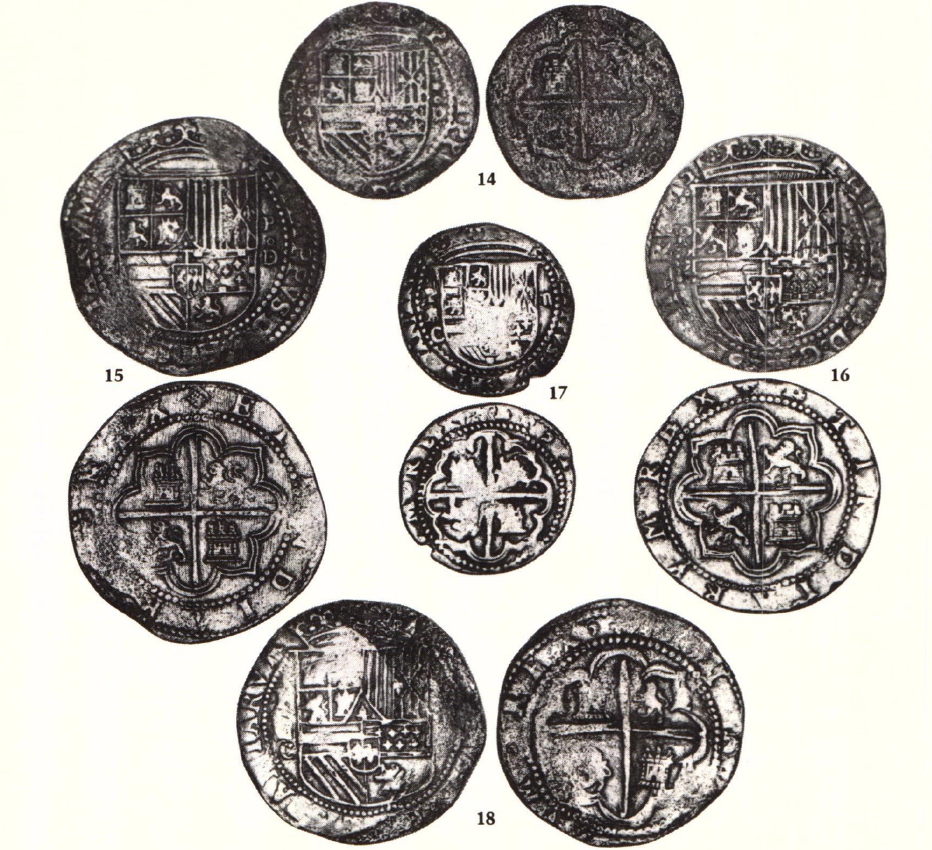
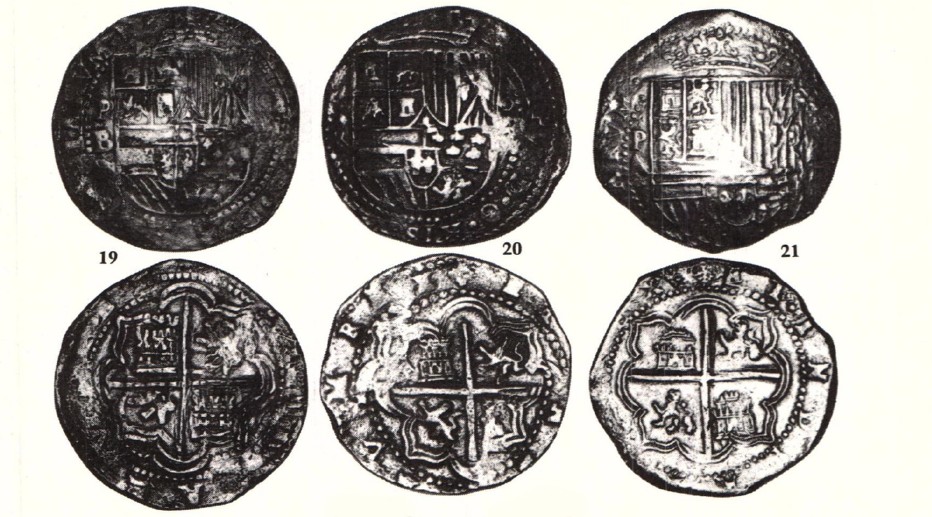
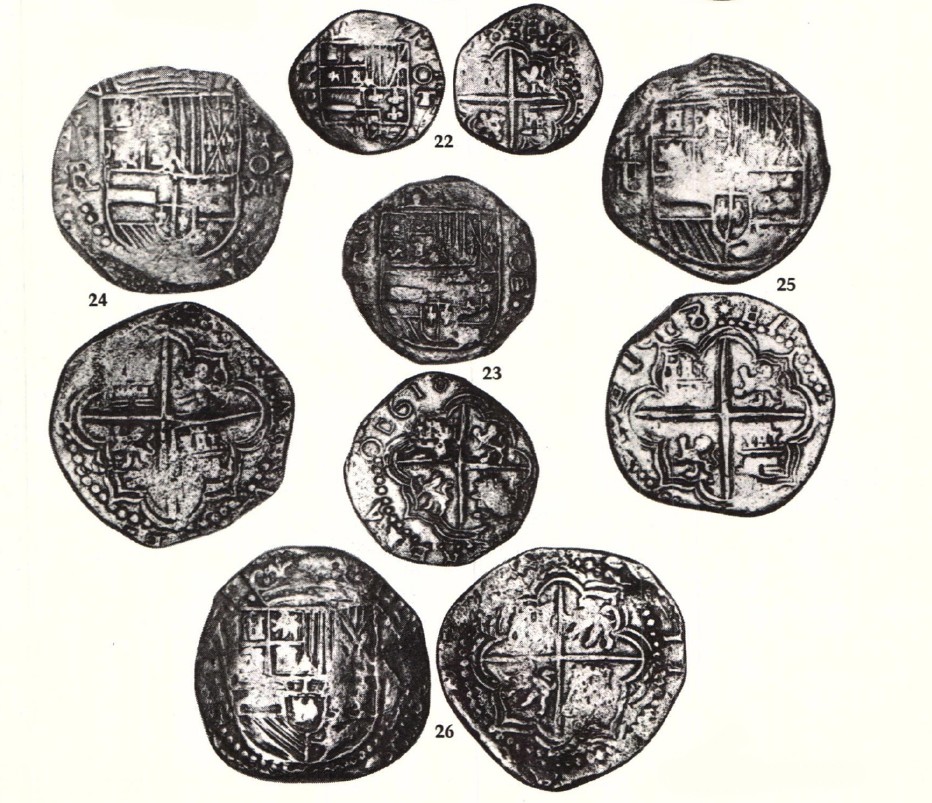
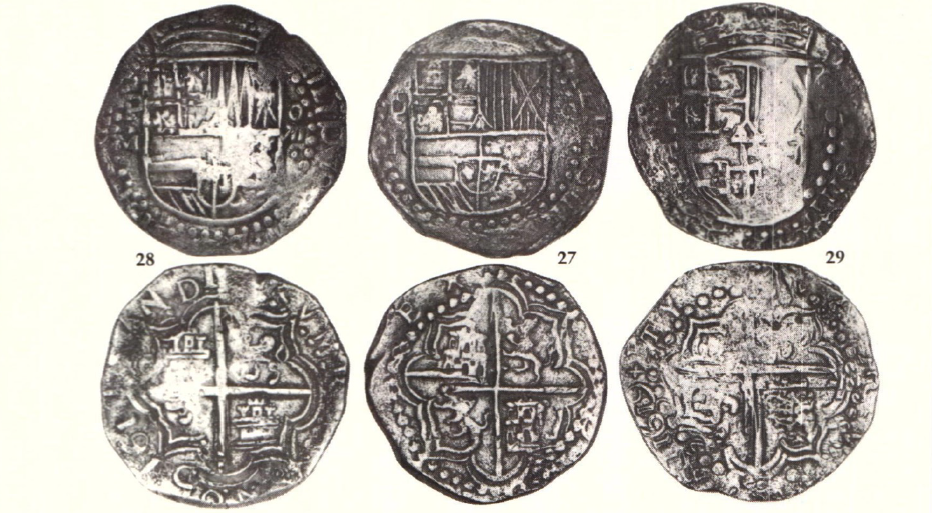
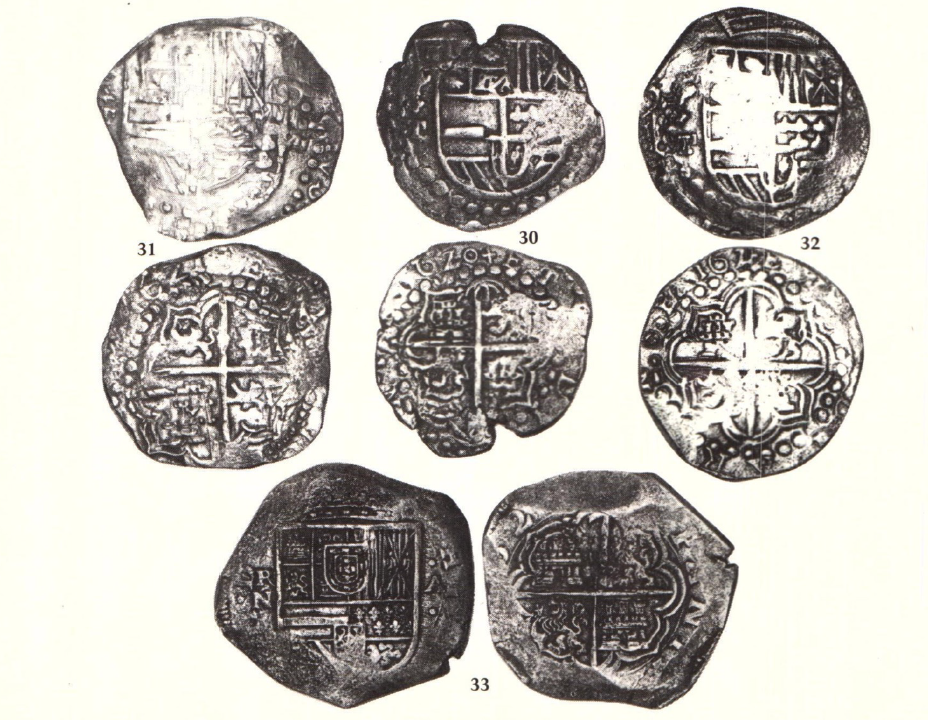
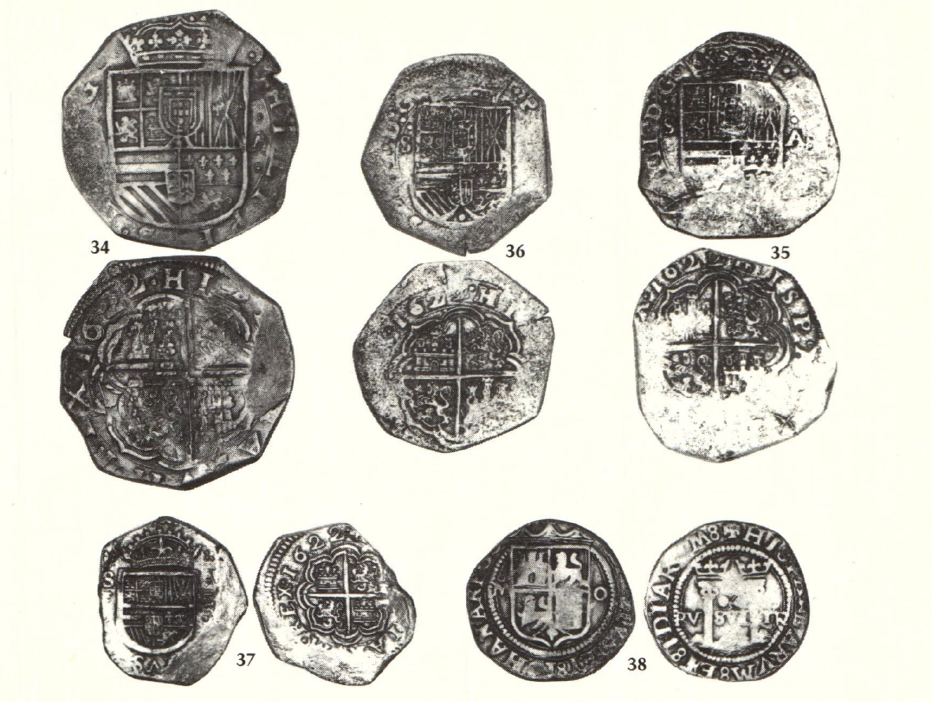
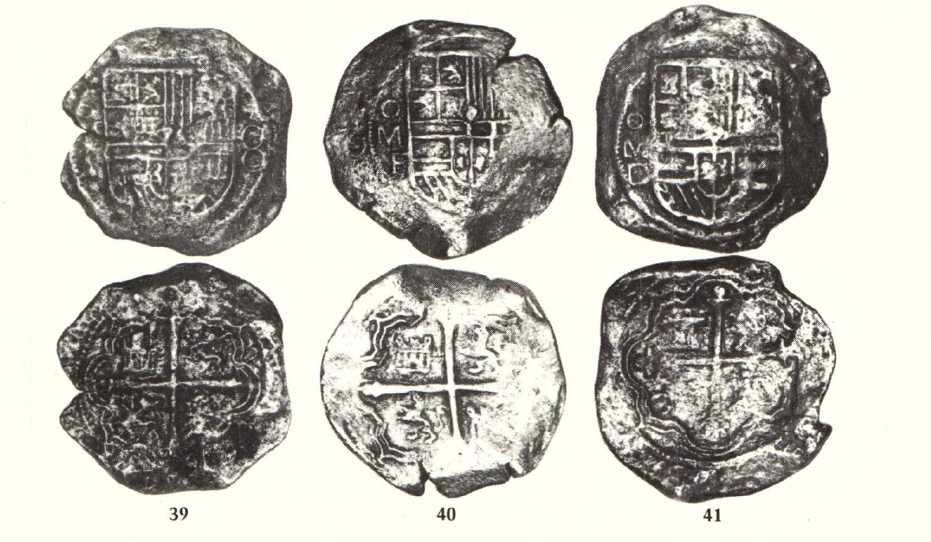
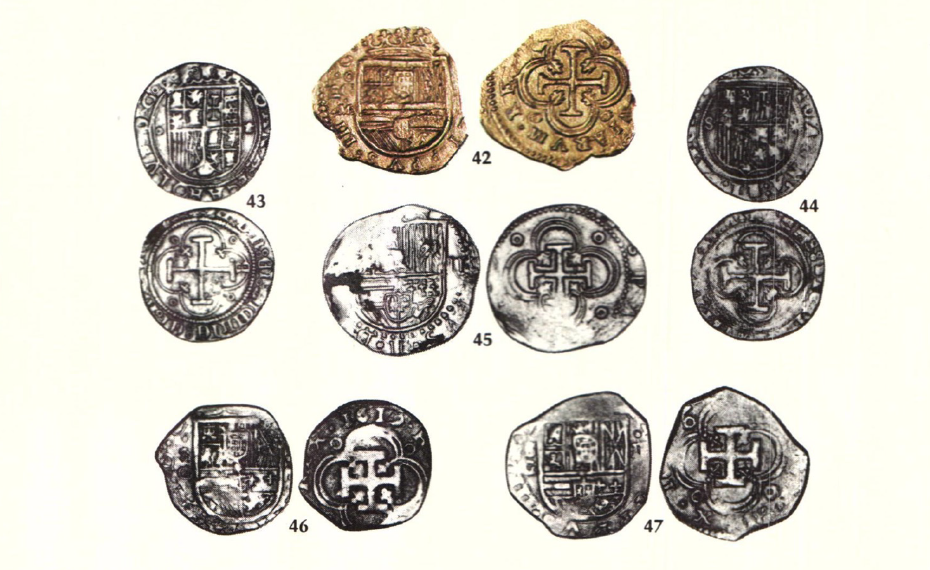
Grading System
Nearly 110,000 coins have been processed, cleaned and graded. The following commentary and illustrated specimens explain the system used by Treasure Salvors to assign grades to the coins of the Atocha hoard. "Grade I" represents the highest degree of preservation, while "Grade IV" indicates the lowest.
Details such as double strike; odd, reversed or broken shields; or transposed lions and castles on the reverse are noted but do not affect the grade.
Coins with legible inscriptions that are misspelled or have letters reversed; pieces that exhibit transposed mint marks or assayer marks; and specimens that are almost perfectly round, flat and possess extraordinarily fine engraving, are noted and possibly added to the research collection for further study. Most of the coins recovered exhibit severe seawater damage. The higher quality specimens generally are from the interior regions of the larger coin "chests" or smaller clumps. In addition, thousands of fragments are not identifiable. Every coin grading below Grade IV is considered a fragment.
Grade I
A clean strike should exist on both the obverse and reverse. No pitting or erosion should be evident except for details missing at edges. Mintmarks and assayer marks and other details, such as shield, outside legend, and lions and castles, should be clearly visible. No cracks or smears should mar details.
Grade II
A Grade II specimen should resemble a Grade I coin except for the presence of smudging, discoloration, cracks or erosions that obscure the details outlined for Grade I. Either the mintmarks or assayer marks, some details of the shield, and at least one each of the lions and castles should be identifiable.
Grade III
One side should be fairly legible and the other reasonably so. The piece should resemble a Grade II coin except for pitting; absence of detail on either the shield or cross; discoloration; erosion of one edge beyond the mint, assayer or denomination spaces at the sides; or erosion of the entire crown at top or into the shield at the bottom. The mint should be easily recognized from cross details, and at least some of the shield details should be legible.
Grade IV
One side should be identifiable as a coin of this period by any of the details given in the three higher grades.
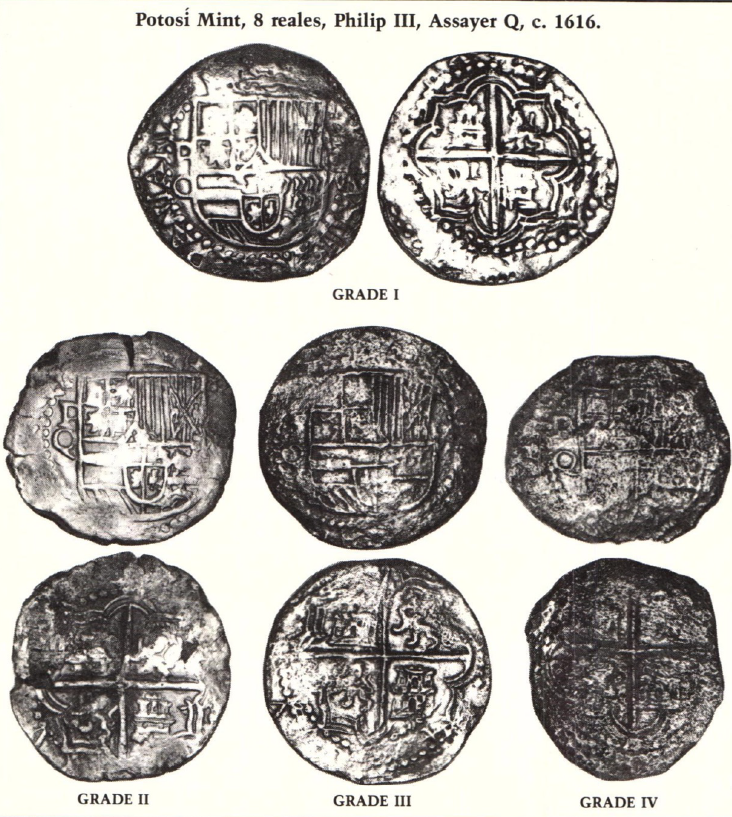
Marketing Strategies
Treasure Salvors' plans for marketing the coins of the Atocha have not yet been finalized, although the vast majority of coins, as well as most of the other treasures, eventually will go to the many investors who have supported the company. Treasure Salvors surely will undertake a major marketing effort. It is known that a few credit card corporations are interested in offering the Atocha coins through their monthly mailings.
Many seem to think that any marketing plan would be targeted at the general public, not the numismatic community. The effect of such a plan on existing collections is uncertain, though some experts feel that the great romantic interest in the treasure would create a strong market for the coins in any sector, and devaluation of existing collections would be short-lived. We can only wait and see.
Conclusions
Whether you respect Mel Fisher for his dogged persistence or doubt his integrity, one thing cannot be denied—he has made one of the most important numismatic discoveries of all time. The sheer number of pieces recovered suggests that much knowledge will be gained about the coins of this period, and, like it or not, the new information will be difficult to refute.
Some archaeologists feel the discovery of the Atocha by a private firm is a tragedy, as very little of the treasure is likely to find its way to museums, where it can be fully studied and preserved. Some criticize Treasure Salvors for not using proper care and recognized techniques in its salvage operations, while others feel that Fisher's group is doing a creditable job in view of the magnitude of the find.
The Mel Fisher Maritime Heritage Society is committed to supplying scholars of Spanish colonial coinage with whatever computer-retrievable information is available. Membership in the society is open to all interested individuals and includes its official journal, the Astrolabe, regular newsletters, discounts on books, and reduced admissions to all sponsored events. Annual membership dues are $10 and are tax-deductible. Applications and additional information can be obtained by writing to the Mel Fisher Maritime Heritage Society, P.O. Box 511, Key West, FL 33041.
Acknowledgements
The ANA wishes to thank Treasure Salvors, Inc. and its crews, divers, headquarters staff and employees for their assistance in the preparation of this article. Special thanks are due Bleth McHaley, Leah and Ted Miguel, Taffi Fisher, Doug Douglas and Sandy McKinney for their special help and courtesy.
A native of Indiana, Neil Harris served the ANA as historian before assuming editorship of The Numismatist in 1974.
ADDITIONAL SOURCES
Burgess, Robert E. They Found Treasure. New York: Dodd, Mead and Company, 1977.
Daley, Robert. Treasure. New York: Simon & Schuster, Inc., 1986.
Lyon, Eugene. "Santa Margarita: Treasure from the Ghost Galleon." National Geographic, February 1982, pp. 228-43.
The Search for the Atocha. New York: Harper & Row Publishers, lnc., 1979.
"The Trouble with Treasure." National Geographic, June 1976, pp. 786-809.
Mathewson, R. Duncan III. Archaeological Treasure: The Search for Nuestra Senora de Atocha. Woodstock, Vermont and Key West, Florida: Seafarers Heritage Library, 1985.
Treasure of the Atocha: A $400 Million Archaeological Adventure. New York: Pisces Books, 1986.
National Geographic Society. Quest for the Atocha. Explorers Television Productions, 1986.
Treasure Salvors, Inc. The Treasure of 1622. Key West, Florida: Treasure Salvors, Inc., 1981.
About the American Numismatic Association
The American Numismatic Association (ANA) is a nonprofit organization dedicated to educating and encouraging people to study and collect coins and related items. The Association serves the academic community, collectors and the general public with an interest in numismatics.
The ANA helps all people discover and explore the world of money through its vast array of educational programs including its museum, library, publications, conventions and numismatic seminars and webinars.
About The Numismatist
This beautifully illustrated monthly magazine is packed full of articles and features written by leading numismatic experts covering all facets of the hobby, from coins and tokens to medals and paper money … plus hobby news from across the globe.

